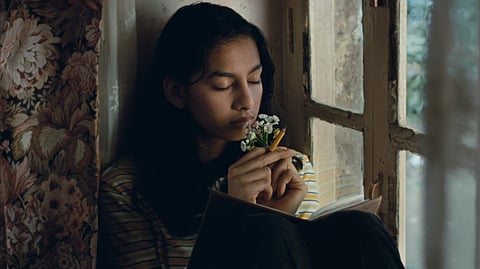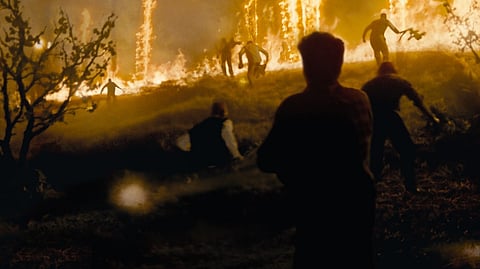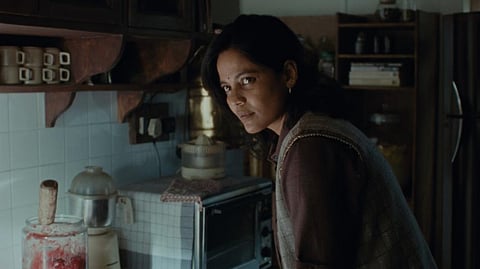Raam Reddy’s visually arresting The Fable centres a family of four on a Himalayan orchard estate in northeastern India. The year is 1989. It’s spring-time. The film is cast through the lens of memory. A voiceover spins out the events that supposedly happened thirty-five years ago. It’s the perspective of an outsider, the estate manager Mohan (Deepak Dobriyal) who’s relating the incidents. So though we hang with the family, Reddy’s screenplay reserves a distance, a teasing enigma which plays with how the family is perceived. Within the marvellous single-shot opening sequence, the film’s to-and-fro between the mundane and magical is immediately established. The family patriarch, Dev (Manoj Bajpayee), steps out of the house after curiously applying an ointment on his shoulders, walks into the outhouse and seems to put on a kind of harness. In the dark, it’s unclear. The sunlight reveals it as mighty wings. Coolly he leaps off a mountain edge and takes flight.
The Fable Review: Raam Reddy’s Sublime Second Feature Glides Between The Real And Dreamlike
The Manoj Bajpayee-led film freely mixes memory, imagination and lore in baring the past
The fantastical blends in matter-of-factly. His daughter Vanya (Hiral Sidhu), who’s back from her hostel on a break, asks him about the wings, its material and the ease of flight. This is the closest we come to an acknowledgement of Dev’s flights, few of which crash-punctuate certain sections. But it does feel like it’s a shared secret in the family.

As a storyteller, Reddy isn’t interested in big, flashy revelations or a tangle of plot. His film unfolds instead as impressionistic fragments. A whiff of a plot point, which triggers the central crisis, comes through mysterious fires set off in various areas of the sprawling orchards. Dev receives the continued reassurances of the workers who come from the local village of Mool Gaon that there’s no ill will against him. Could the sheriff be behind the scorched trees? The family’s cook insinuates the sheriff’s greed for bribes, that he might be playing both sides in the guise of mediation. There are also whispers of disquiet among the villagers about the use of pesticides. A death occurs. The situation spirals, though Dev emotionally isolates himself from it as long as he can.
He is placid and detached. Initially it seems like nothing can ruffle him. With a tired resignation, he watches over the once-colonial apple orchard estate from a remove. His family is more active, demanding and assertive. Soon, however he does reveal his insecurities, petty, human fears. Distrust creeps in. Divisive lines sprout in a supposedly peaceful place.

Much of the film’s dreamy textures draw from Sunil Borkar’s evocative cinematography; a speckled graininess perforates the frames, be it the lush pine expanse, mountain peaks or the darkness filling the screen. Shot on 16mm film, The Fable has the touch of a half-faded residue. Its vivid imagination holds something fragile and fleeting within. Therefore, the film exudes a sense of inchoate tangibility, of life seen through multiple veils of temporal distance, speculation and folk lore. Images are flecked through an aura of revisitation.
Then there are the night-time scenes which come fully alive especially in the silent, wandering spells of Vanya. With a blossoming sexual curiosity, she is drawn to one of the boys in the nomadic tribe passing through the glade. Reddy crafts these moments with just a tint of erotic interest and tension. Borkar’s camerawork wholly sublimates you in the rich, languid, transporting atmosphere. The CGI-infused darting fireflies slink at the corners of the frames, until they engulf a character in a blaze in an indelible scene.
The Fable fuses the everyday with a twinkling, wondrous quality. Reddy threads in the vast unknown of the cosmos, cues andnods to it sprinkled throughout. One of the village women (Tilottama Shome) tells a bed-time tale to her kid about fairies who got accidentally stuck in the earthly realm. Both the two songs Dev’s wife Nandini (Priyanka Bose) sings on being requested invoke “eternal bliss” and the “land of enlightened”. Boundaries between the mortal and transcendental blur; the film is playfully ambiguous, wrapping the strange and sublime with expectedness and familiarity. Everything is elusively connected.

Yet the film does have frustrating unwieldiness and hollowness whenever it moves to the village. There’s an off-putting summariness, a tediously naïve gaze at the villagers. The starting tone is idyllic and that it is deceptive is amply clear. You sense right away the serenity, the supposed harmony the voiceover talks of, will crack soon. What’s fuzzy is the degree of sincerity and irony in the narration whenever it brings up this apparent amity that stands threatened by the fires. The more the film delves into the conflicts between Dev and the over-faithful workers, it turns blunt and commonplace, the politics superficial. Instead the film is subtly effective in the space the privileged, largely English-speaking family prefers between the house and straying locals.
How much of the tranquil pastoral built on the spoils of colonialism, which opens the film, is just an empty perception bound to fall apart? A fabulously imaginative film, The Fable lulls and unnerves, rambling through storytelling, legacy and memories with a gentle, whimsical and dark spirit.
The Fable had its India premiere at the MAMI Mumbai Film Festival 2024.

